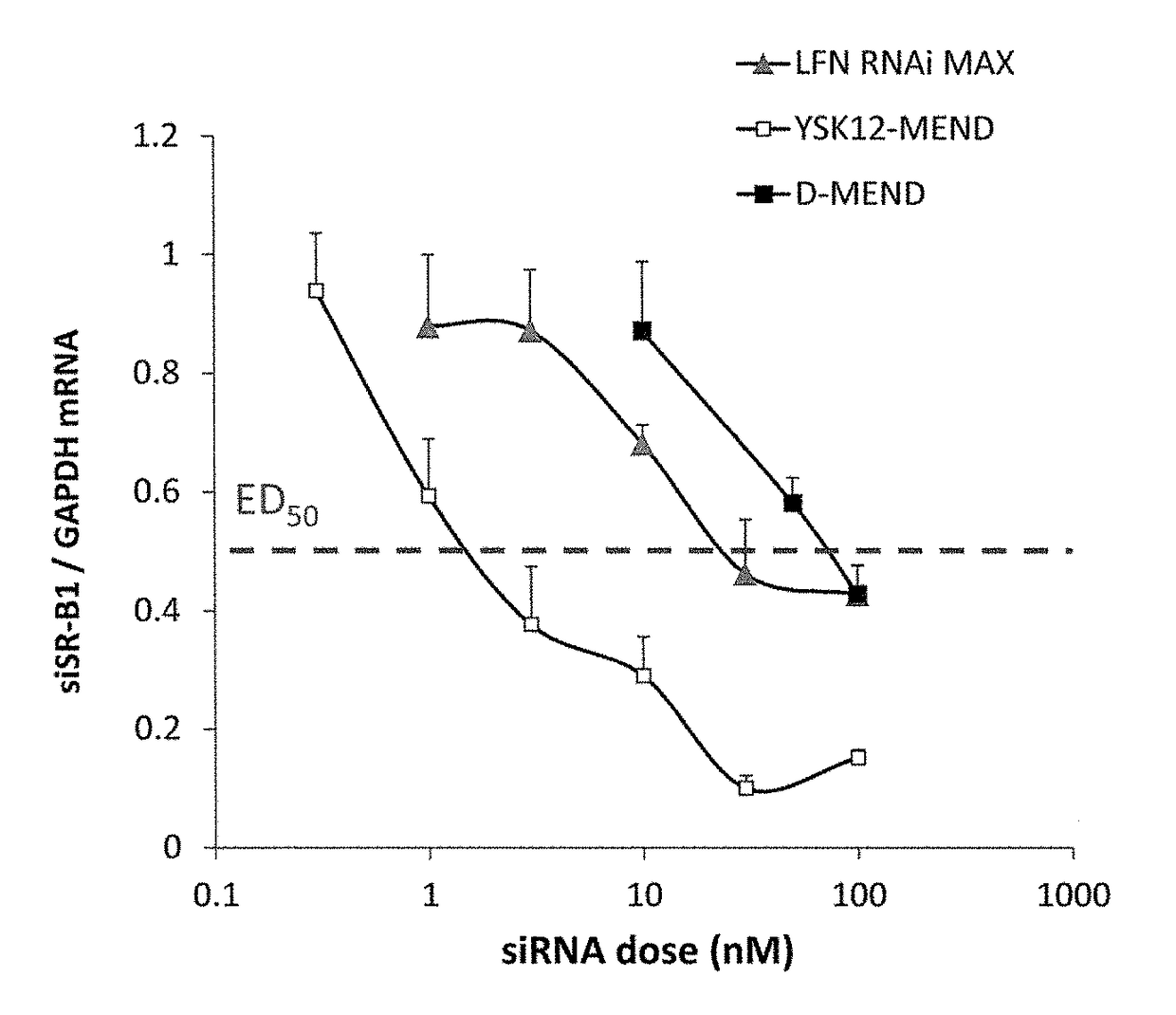LIPID MEMBRANE STRUCTURE FOR siRNA INTRACELLULAR DELIVERY
a technology of lipid membrane and sirna, which is applied in the direction of aerosol delivery, immunology disorders, drug compositions, etc., can solve the problems of reducing the knockdown efficiency of dendritic cells, limiting the knockdown efficiency to about 40%, and using a conventional artificial delivery system tends to markly reduce the knockdown efficiency. , to achieve the effect of efficient endosomal escaping, efficient endosomal escaping, and high endosomal escaping
- Summary
- Abstract
- Description
- Claims
- Application Information
AI Technical Summary
Benefits of technology
Problems solved by technology
Method used
Image
Examples
example 1
of YSK12
[0084]
[0085]According to the scheme mentioned above, YSK12 was synthesized from linoleic acid.
(1) (9z,12z)-Octadecadien-1-ol
[0086]Lithium aluminum hydride (2.73 g, 72 mmol) was suspended in tetrahydrofuran (THF, 190 mL) cooled at 4° C. Linoleic acid (10 g, 36 mmol) was added dropwise to the suspension, and the resulting mixture was stirred for 10 minutes. Then, the mixture was refluxed overnight with heating on an oil bath. After cooling the mixture, 1 mol / L aqueous sodium hydroxide (100 mL) was added to terminate the reaction. Then, the reaction mixture was diluted with ethyl acetate (100 mL), and filtered, and the filtrate was washed with saturated aqueous sodium hydrogencarbonate. Then, the organic layer was collected, and dried over anhydrous sodium sulfate. The organic layer was filtered, and the solvent was evaporated by using a rotating evaporator to obtain a crude product. The crude product was purified by silica gel chromatography (elution solvent, hexane:ethyl acet...
example 2
on of YSK12-MEND
[0104]YSK12-MEND was prepared by the alcohol dilution method. To a solution containing YSK12, 1-palmitoyl-2-oleyl-sn-glycero-3-phosphoethanolamine (POPE), cholesterol (Chol), 1,2-dimyristoyl-sn-glycerol, and methoxy polyethylene glycol 2000 (DMG-PEG 2000) in a total lipid amount of 505 nmol in 90% t-butanol (400 μL), an aqueous solution (200 μL) containing siRNA (600 pmol) was added with stirring. A 20 mM citrate buffer (2 mL) was further added to the mixture with stirring, then PBS (3.5 ml) was added to the mixture, and then the resulting mixture was subjected to ultrafiltration.
[0105]The lipid composition of YSK12-MEND was optimized by using mouse dendritic cells. Dendritic cells (6×105) were transfected with siRNA of which target is SR-B1 at an siRNA concentration of 5 nM or 10 nM in the absence of serum, a medium containing serum was added 2 hours thereafter, the cells were collected after 22 hours, and knockdown efficiency was evaluated (Warashina S. et al., Bio...
example 3
on of Gene Expression in THP-1 Cell (Human Monocyte Cell Line)
[0110]YSK12-MENDs enclosing GAPDH silencer siRNA or control silencer siRNA were prepared in the same manner as described in Example 2. The cells suspended in OPTI-MEND were inoculated into wells of a 12-well plate at a density of 6×105 cells / well, and YSK12-MEND or Lipofectamine RNAiMAX was added so that the final concentration of siRNA became 3, 10, or 30 nM. After culture for 2 hours, a culture medium containing serum was added, and the culture was continued for 22 hours. Then, the cells were collected, and mRNA amounts were evaluated by real-time RT-PCR. The results are shown in FIG. 12. It was demonstrated that YSK12-MEND can more efficiently attain gene knockdown compared with Lipofectamine RNAiMAX.
PUM
| Property | Measurement | Unit |
|---|---|---|
| particle size | aaaaa | aaaaa |
| particle size | aaaaa | aaaaa |
| PDI | aaaaa | aaaaa |
Abstract
Description
Claims
Application Information
 Login to View More
Login to View More - R&D
- Intellectual Property
- Life Sciences
- Materials
- Tech Scout
- Unparalleled Data Quality
- Higher Quality Content
- 60% Fewer Hallucinations
Browse by: Latest US Patents, China's latest patents, Technical Efficacy Thesaurus, Application Domain, Technology Topic, Popular Technical Reports.
© 2025 PatSnap. All rights reserved.Legal|Privacy policy|Modern Slavery Act Transparency Statement|Sitemap|About US| Contact US: help@patsnap.com



